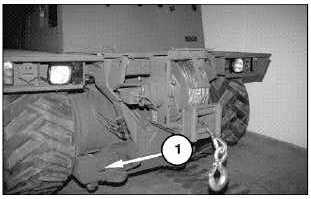TM5-2430-200-10
85
Operation Section
Towing Information
Towing Information
Personal injury or death could result when towing
a disabled machine incorrectly.
Be sure all necessary repairs and adjustments
have been made before a machine that has been towed
to a service area is put back into operation.
Follow the recommendations below to properly
perform the towing procedure.
NOTICE
The winch cable is rated at 195 712 N (44,000 Ib). This
cable can be used for self-recovery but cannot be used
to tow another DEUCE.
NOTICE
This
machine
is
equipped
with
internally,
spring-
applied parking brakes. The parking brakes must be
hydraulically released before the machine can be
towed. Also, the final drives must be disabled before
the machine is towed. Failure to release the parking
brake
and/or
disable
the
final
drives
before
the
machine is towed can damage the machine. Notify
Unit Maintenance to perform these procedures if the
machine must be towed.
Note: This information is not authorization for the operator
to maintain additional tools or to perform maintenance
tasks.
These towing instructions are for moving a disabled
machine a short distance, at low speed (no faster than
2 kph [1.2 mph]) to a convenient location for repair.
These instructions are for emergencies only. Always
haul a disabled machine if long distance moving is
required.
Shielding must be provided on the towing machine to
protect the operator if the tow line, or bar, should
break. The rear window screen on the DEUCE must
be down when the machine is towing or being towed.
Do not allow an operator on the machine being towed since
it is not possible to control the steering and braking.
Before towing, make sure the tow line, or bar, is in
good condition and has enough strength for the
towing situation involved. Use a towing line, or bar,
with a strength of at least 1.5 times the gross weight
of the towing machine for a disabled machine stuck in
the mud, or when towing on a grade.
Do not use a chain for pulling. A chain link may break,
causing possible injury. Use a wire rope cable with
loop or ring ends. An observer (in a safe position)
should stop the pulling procedure if the cable starts to break
or unravel. Stop pulling whenever the pulling machine
moves but the towed machine does not.
Keep the tow angle to a minimum. Do not exceed a
30-degree angle from the straight-ahead position.
Quick machine movement could overload the tow line,
or bar, and cause it to break. Gradual and smooth machine
movement works better.
Normally, the towing machine should be as large as
the disabled machine. Satisfy yourself that the towing
machine has enough brake capacity, weight and
power, to control both machines for the grade and distance
involved.
To provide sufficient control and braking when towing
a disabled machine down a hill, a larger towing
machine or additional machines connected to the front may
be required. This prevents it from rolling uncontrollably.
All different situational requirements cannot be given,
as minimal towing machine capacity is required on
smooth level surfaces, and increased capacity is
required on inclines or poor surface conditions.
Any towed machine, when loaded onto a trailer, must
be equipped with its own brake system which is
operable from the operator’s compartment.
When towing the machine, use towing brackets (1) at the
rear of the machine, on both sides of the winch.

